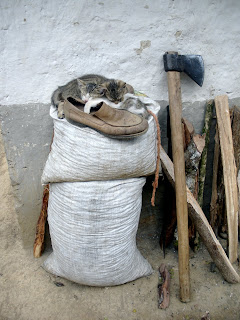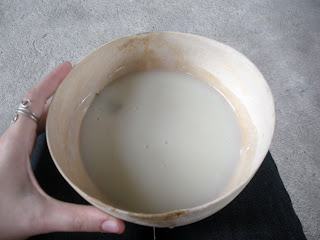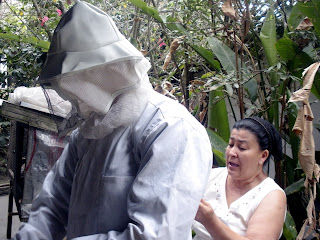Tuesday, April 28, 2009
Triste triste



Leaving at noon on Friday. Not really sure if I want to....
A few last photos from two different communities, Las Mercedes and Buena Vista.
Tortilla woman
 At the Heifer office today. Every time I'm here, this woman's voice floats through the window from the street at about the same time. "Tortillas! Tortillas!" It almost sounds angry. Finally went outside to see who the voice belonged to today, but the woman turned the corner and walked away when she saw my camera. On to the next block to sell her fresh tortillas.
At the Heifer office today. Every time I'm here, this woman's voice floats through the window from the street at about the same time. "Tortillas! Tortillas!" It almost sounds angry. Finally went outside to see who the voice belonged to today, but the woman turned the corner and walked away when she saw my camera. On to the next block to sell her fresh tortillas.
Monday, April 27, 2009
North Americans
So I finally asked Gloria why she says "North Americans" instead of "Americans." A lot of people down here do that. And I got the answer I was hoping for. North, Central, South, we're all Americans, not just those of us who live in the States. So when she refers to people from the U.S., she uses "North Americans."
Pretty arrogant when you think about it, how we refer to ourselves as the only Americans....
Rainy days are here again
This is Honduras (tambien)
 Stacks of tomato crates near Bonete.
Stacks of tomato crates near Bonete.Roosters crowing and dogs barking all through the night in the South.
A car passing a car passing a truck on a blind curve on the road to San Pedro Sula.
Wandering vendors, shouting "tortillas" through the streets of downtown Tegus.
Everywhere strangers greeting strangers, "buenos dias."
Dionysus in Tegucigalpa
Down time
There are so many people in this house
 Don Jose. He lives up the road at the retreat house. Lately he's been fighting the fires that have raged entirely too close. Has a big, furry dog. Always wearing that hat. Usually smiling.
Don Jose. He lives up the road at the retreat house. Lately he's been fighting the fires that have raged entirely too close. Has a big, furry dog. Always wearing that hat. Usually smiling.
Mertala. Doesn't actually live with the Wheelers, but she's at the house 6 days a week. She does most of the cleaning, including the laundry. Also takes care of the parrots. One of them says "Mer-TA-la" all day long, even when she isn't there.

Luisa. She has lived with the Wheelers for more than 20 years. She does most of the cooking. Also helps out with groups when they stay at the retreat house. Very patient with my Spanish. Gentle.

And, of course, Tim and Gloria. Here they are playing a fiercely competitive game of Chinese checkers (something they do almost every night).
Not pictured:
Joaquina. 18. She lives with the Wheelers and goes to school on a scholarship they got her. Sewing school by day and middle school on the weekends. Originally from Las Mercedes. Constantly giggling.
Pramuel. From La Moskitia, the Honduran rain forest. Has lived with the Wheelers for 2 years. Not really sure what he does. Very elusive.
Friday, April 24, 2009
This is Honduras
 Will they or won't they? Never knowing if the lights will turn on in Copan.
Will they or won't they? Never knowing if the lights will turn on in Copan.Eternal optimism. Separate faucet handles for hot and cold water, even though turning the hot water handle rarely produces the desired effect.
New meets old. Outside of Siguatepeque, a man riding his horse alongside the highway while talking on his cellphone.
Lip signals. People everywhere puckering up, pointing with their lips instead of their hands.
A picture's worth...
Old and new


 Here's what the old houses in Chonco look like. Sticks and straw. The whole community is built on the side of a mountain. A steep path connects each level, which has maybe 5 or 6 houses. When Tim and Gloria first came there, there wasn't a road. The people in Chonco had to carve one out of the mountain just to be able to walk supplies in for houses.
Here's what the old houses in Chonco look like. Sticks and straw. The whole community is built on the side of a mountain. A steep path connects each level, which has maybe 5 or 6 houses. When Tim and Gloria first came there, there wasn't a road. The people in Chonco had to carve one out of the mountain just to be able to walk supplies in for houses. Chonco is a Maya-Chorti village, so the people have land rights. But the land they received from the government is horrible for farming. All rock, no dirt. They walk 2 hours every day just to get to their fields, which are steep and rocky. So they're having a hard time farming.
But things have definitely improved. Gloria said before the housing project there was a lot of malnutrition among the children and almost everyone was illiterate. Since they became organized, the people are healthy and have built their own school. Plus, they have a road and houses. A little effective community organizing goes a long, long way.
Chonco


 Seventh stop: Chonco. Not really part of the Heifer study tour. Gloria wanted to show the group what kind of work she does in communities. Chonco had a housing project through Tim and Gloria. Now they have some Heifer cows, too. The village is really close to the Guatemalan border, about 1 km. Up in the mountains around Copan, on an unbelievably narrow road that runs alongside the Copan river. I still can't believe we didn't fall in.
Seventh stop: Chonco. Not really part of the Heifer study tour. Gloria wanted to show the group what kind of work she does in communities. Chonco had a housing project through Tim and Gloria. Now they have some Heifer cows, too. The village is really close to the Guatemalan border, about 1 km. Up in the mountains around Copan, on an unbelievably narrow road that runs alongside the Copan river. I still can't believe we didn't fall in. for mom
Cat lady

 Cerro azul. I could not leave the kittens at Luis' farm alone. They were just so tiny and floppy. Giant ears and tails. The little guy in the picture with me sat on my lap the whole time Luis was talking to us (maybe 45 minutes). I'm probably going to be one of those old women who lives alone with her twenty cats....
Cerro azul. I could not leave the kittens at Luis' farm alone. They were just so tiny and floppy. Giant ears and tails. The little guy in the picture with me sat on my lap the whole time Luis was talking to us (maybe 45 minutes). I'm probably going to be one of those old women who lives alone with her twenty cats....
Celery on ice
Bet you can't eat just one

 Around Cerro azul we visited another community where women make plantain chips. They formed a co-op and together they rent this tiny empty house where they cook all day long. Each group of women has a specific day of the week when they can use the space. They sell the chips in the nearest market. We got to eat all of the plantain chips that were broken. This was probably my favorite stop.
Around Cerro azul we visited another community where women make plantain chips. They formed a co-op and together they rent this tiny empty house where they cook all day long. Each group of women has a specific day of the week when they can use the space. They sell the chips in the nearest market. We got to eat all of the plantain chips that were broken. This was probably my favorite stop.
Cerro azul

Visited Don Luis' farm. Lots of Heifer crops and animals. Here's some fresh broccoli and cauliflower.

Tilapia pond. Luis just got this project. Not sure if he plans on having enough fish to be able to sell some.
 Terraced crops. Planting horizontal instead of vertical rows on a hillside helps prevent soil erosion.
Terraced crops. Planting horizontal instead of vertical rows on a hillside helps prevent soil erosion.
Up in the sky



Sixth stop on the Heifer study tour: Cerro azul. Beautiful small village high up in the mountains around Copan. We hired a microbus to take us up a ridiculously bumpy dirt road, maybe an hour into the mountains. Cerro azul means blue hill, supposedly because the surrounding hills (more like mountains) look blue.
Wednesday, April 22, 2009
The people, united, will never be defeated (con't)



So Gloria and I got out of the bus, and the rest of the group followed us (which we didn't anticipate). Excited and nervous. Before we crossed the barbed wire fence, Gloria shouted over it and asked if they would hurt us if we came in. The guys standing guard said no, so we hopped over. Someone kept blowing a whistle which brought a bunch of people over. They surrounded us with their machetes in a tight circle.
Gloria did the translating (and most of the talking). She told them who we were and that we sympathized with their cause. About 350 people, landless Ladino campesinos, trying to reclaim this piece of land. When we visited them on Tuesday, they had been there for four days. They're living in these tiny tarp tents with plastic chairs and sleeping bags and not much else. They plan on staying until they get the land or the government kicks them out.
They seemed really excited that we were interested in their cause. Gloria exchanged information with the leaders. She wants to try and help them if she can. It was the most intense experience. These people have nothing, and they're doing everything the can to change their situation. A critical mass, direct action community organizing, frustrated talking, machetes. Amazing.
The people, united, will never be defeated



The coolest thing that has ever happened to me. Really.
Gloria and I knew about a land reclamation going on in central Honduras. We drove by it on the study tour and stopped to talk with the people. A group of campesinos are occupying this piece of land in the hopes of getting the government to give it to them. They don't have anything, not even land to build houses on. In the 80s, land reclamation was a popular tactic among Ladino campesinos in Honduras. And it was somewhat successful because it was legal. A group of people would invade private land that wasn't being used and the government would have to give it to them if they could prove they could use it. But now the laws have changed, and Ladinos have no legal right to reclaim land.
We'll see what happens with these guys. The banner says, "Without agrarian reform, no food sovereignty."
Santa Rosa, pt. 2
Santa Rosa, pt. 1

 Fifth stop: Santa Rosa. Still in Northwest Honduras. We visited one of Heifer's farm schools. People come here from different villages and learn before receiving a project from Heifer. Lots of crops and animals. This was probably my favorite stop, mainly because of all the fresh fruit we got to eat. Pineapple, mango, banana, watermelon. All picked fresh from the farm.
Fifth stop: Santa Rosa. Still in Northwest Honduras. We visited one of Heifer's farm schools. People come here from different villages and learn before receiving a project from Heifer. Lots of crops and animals. This was probably my favorite stop, mainly because of all the fresh fruit we got to eat. Pineapple, mango, banana, watermelon. All picked fresh from the farm.
Guanas, pt. 1


Fourth stop: Guanas. Northwest Honduras. Small farms with a variety of animals and crops. Delicious local snack: chilate (I think). Warm white corn soup, like cream of wheat. Then a sort of plantain jelly. You mix them together. Served in a traditional gourd bowl.
 Also pineapples. I thought pineapples grew high up in trees, but it's more like a bush.
Also pineapples. I thought pineapples grew high up in trees, but it's more like a bush.
Subscribe to:
Posts (Atom)













